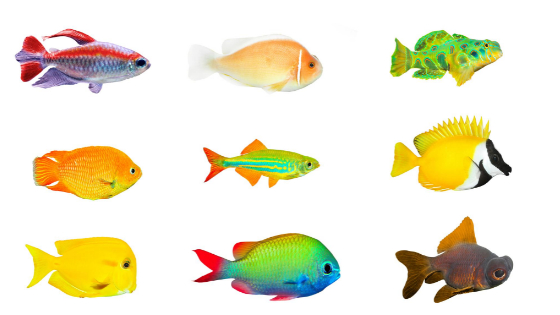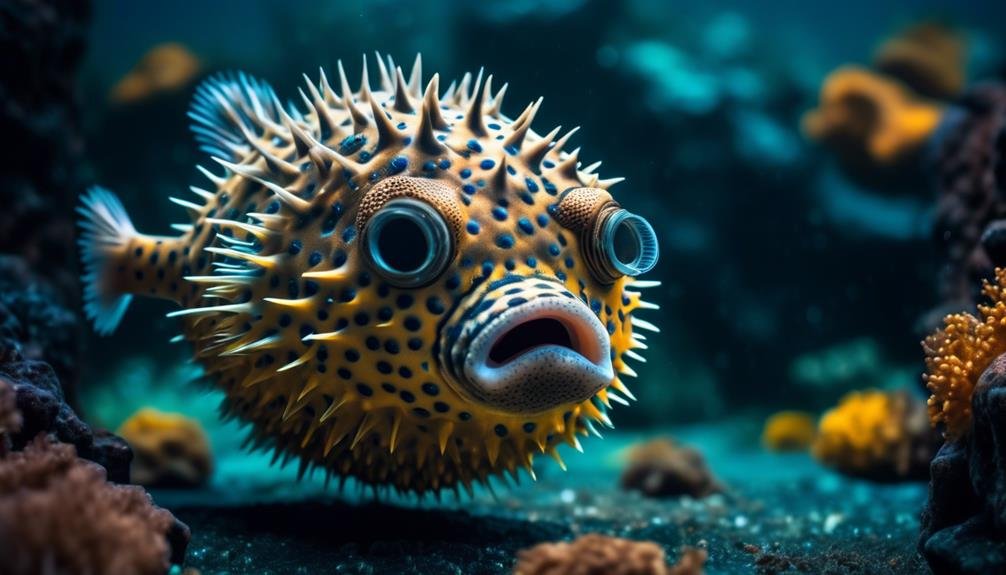
Have you ever wondered how something so beautiful can also be deadly?
Picture this: you're strolling along a picturesque beach, the sun warming your skin and the sound of waves lulling you into tranquility. Suddenly, your eyes are drawn to a small, vibrant creature swimming gracefully in a nearby tide pool. Its intricate patterns and striking colors are mesmerizing, and you can't help but be captivated.
But little do you know, this seemingly harmless creature is none other than the pufferfish – a deadly delight that can unleash a lethal toxin with the power to kill.
Curious to know more? Stay with us as we unravel the mysteries of these enchanting yet perilous creatures.
Key Takeaways
- Pufferfish are medium-sized saltwater fish that require a large tank of at least 50 gallons.
- They have the ability to fill their elastic stomach with water for defense and are the second most poisonous vertebrates.
- Pufferfish should be fed a carnivorous diet consisting of squid, krill, clams, and shrimp.
- While they are relatively hardy and adapt well to stable water conditions, they should not be housed with small, slow-moving species due to their predatory nature.
Pufferfish Size and Tank Requirements
Pufferfish require a large tank size of at least 50 gallons and are best suited for saltwater aquariums. These medium-sized fish prefer swimming in the middle region of the tank. When it comes to tank mates, they get along well with Angelfish, Anthias, Batfish, Clownfish, Gobies, and Squirrelfish.
Pufferfish are part of a large family of saltwater fish with over 100 distinct species. Common names for them include balloonfish, blowfish, bubblefish, toadfish, and sea squabs. They've thinner spines compared to porcupine fish and can fill their elastic stomach with water for defense.
Originating from tropical regions of oceans worldwide, they come in various colors and often display complex patterns and markings on their bodies.
Pufferfish are relatively hardy and adapt well to stable water conditions in aquariums. Just make sure to provide them with a sufficiently large tank and plenty of swimming space.
Pufferfish Characteristics and Behavior

With their unique ability to fill their elastic stomachs with water for defense, pufferfish exhibit fascinating characteristics and behaviors. Pufferfish are part of a large family of saltwater fish, with over 100 distinct species. They've thinner spines compared to porcupine fish and are the second most poisonous vertebrates in the world.
Pufferfish originate in tropical regions of oceans worldwide and come in various colors such as tan, brown, grey, black, and white. They often display complex patterns and markings on their bodies.
Pufferfish are relatively hardy and adapt well to stable water conditions in aquariums. They require a sufficiently large tank with ample swimming space and prefer aquariums with numerous caves and hiding places. Due to their predatory nature, they shouldn't be housed with small, slow-moving species.
Pufferfish Care and Maintenance
To properly care for and maintain pufferfish in your aquarium, it's important to provide a sufficiently large tank with ample swimming space and plenty of caves and hiding places. Here are three important considerations for pufferfish care and maintenance:
- Tank size: Pufferfish require a tank size of at least 50 gallons to accommodate their medium size and need for swimming space. A larger tank will also help maintain water quality and stability.
- Hiding places: Pufferfish are known for their shy and reclusive nature. Providing numerous caves and hiding places in the aquarium will help them feel secure and reduce stress.
- Tank mates: While pufferfish can be kept with certain species, it's important to avoid housing them with small, slow-moving fish due to their predatory nature. Compatible tank mates include Angelfish, Anthias, Batfish, Clownfish, Gobies, and Squirrelfish.
Pufferfish Feeding
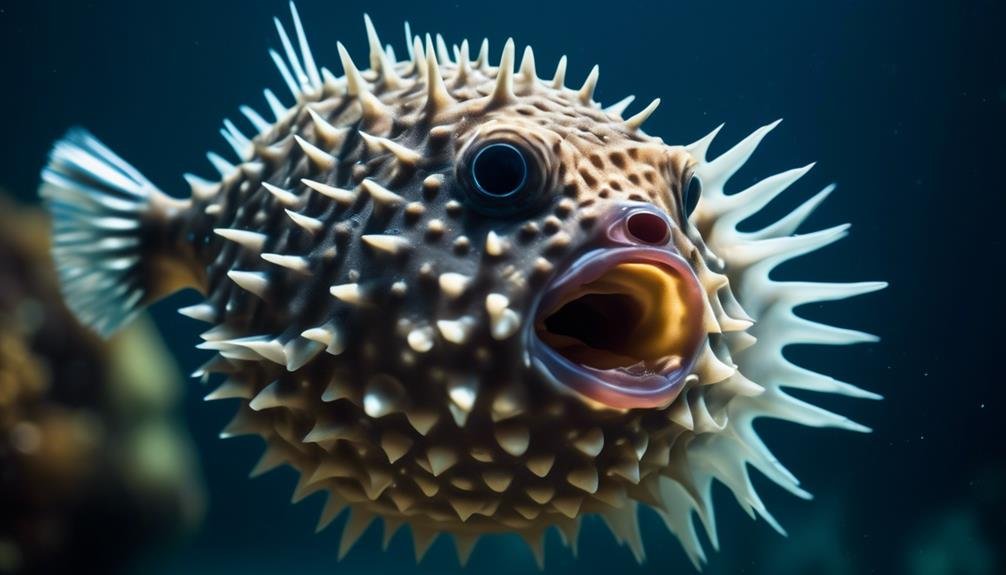
Providing a diverse diet is crucial for the health and well-being of your pufferfish. As carnivores, pufferfish require a meaty diet to meet their nutritional needs. Offer them a variety of foods such as squid, krill, clams, and shrimp. These sources of protein will help keep your pufferfish strong and healthy.
It's important to provide small, frequent meals to prevent overfeeding and maintain water quality in the tank. Be mindful of the size of the food you offer, as pufferfish have small mouths and may struggle to eat large pieces. Remember to observe your pufferfish during feeding to ensure they're eating properly and adjust their diet as needed.
Pufferfish Breeding and Aquarium Varieties
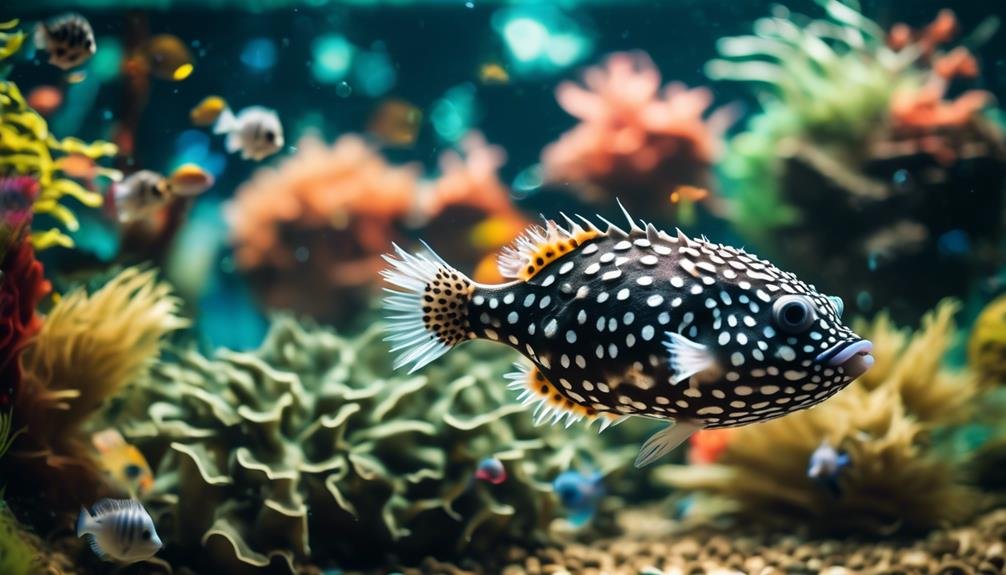
To further explore the world of pufferfish, let's now delve into the fascinating realm of pufferfish breeding and the various aquarium varieties available.
While there are no known reports of successful breeding in home aquariums, pufferfish are pelagic spawners in the wild. This means that they release their eggs into the open water, allowing them to float and develop freely. However, in captivity, replicating these conditions can be difficult.
Despite the challenges, there are still several popular aquarium varieties of pufferfish that enthusiasts can enjoy. Some of these include the Arothron Dogface Puffer, Porcupine Puffer, Saddle Puffer, Saddle Valentini Puffer, and Spiny Box Puffer. Each variety offers unique characteristics and stunning appearances, adding to the allure of these captivating creatures.
Pufferfish Poisonous Defense Mechanism

Pufferfish possess a highly potent defense mechanism through their poisonous spines. These spines contain tetrodotoxin, a potent neurotoxin that can be deadly to predators.
When threatened, the pufferfish inflates its body, making it appear larger and more intimidating. This inflation also causes the spines to stand upright, ready to deliver a painful and potentially lethal sting.
The venom is so powerful that it can paralyze and kill predators within minutes. It's estimated that a single pufferfish contains enough toxin to kill 30 adult humans.
This defense mechanism is crucial for the survival of pufferfish, as it allows them to ward off potential threats and avoid being eaten. It serves as a warning to predators that they should steer clear of these deadly beauties.
Pufferfish Conservation Status

After learning about the fascinating defense mechanism of pufferfish through their poisonous spines, it's important to understand the conservation status of these unique creatures. Despite their intriguing nature, pufferfish face several conservation challenges that threaten their populations.
Here are three key points to consider:
- Habitat loss: Pufferfish rely on specific coral reef habitats, which are being destroyed at an alarming rate due to factors such as climate change, pollution, and destructive fishing practices. This loss of habitat directly impacts the survival of pufferfish.
- Overfishing: Pufferfish are often caught for their meat, considered a delicacy in certain cultures. Overfishing poses a significant threat, as it depletes their populations and disrupts the delicate balance of marine ecosystems.
- Illegal wildlife trade: Pufferfish are targeted for the aquarium trade, where they're highly sought after for their unique appearance. This illegal wildlife trade further contributes to their decline in the wild.
To protect pufferfish, it's crucial to address these conservation challenges and promote sustainable practices that ensure their survival for future generations.
Pufferfish in Popular Culture
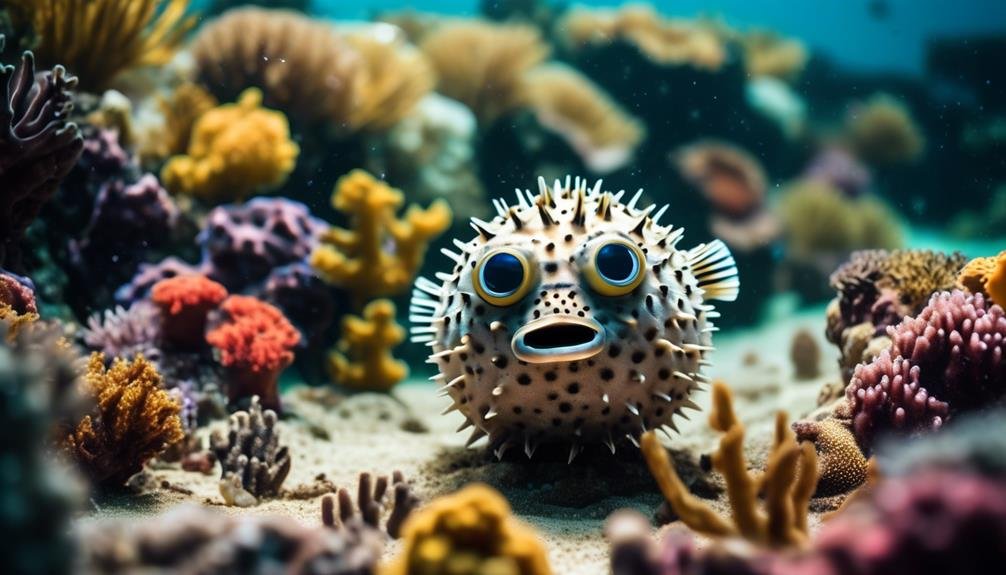
In popular culture, these unique and intriguing creatures have made quite a splash. From their distinctive appearance to their deadly capabilities, pufferfish have captured the imagination of people around the world. They have been featured in various forms of media, including movies, cartoons, and even video games. Below is a table showcasing some notable appearances of pufferfish in popular culture:
| Medium | Title | Year | Description |
|---|---|---|---|
| Film | Finding Nemo | 2003 | Bloat, a pufferfish, is a memorable character in this animated film about a clownfish's journey. |
| TV Show | SpongeBob SquarePants | 1999 | Puffy Fluffy, a pufferfish pet, appears in multiple episodes as a recurring antagonist. |
| Video Game | Super Mario Bros. | 1985 | Pufferfish enemies, known as "Cheep Cheeps," are common obstacles in underwater levels. |
| Comic Strip | Calvin and Hobbes | 1985 | Calvin's imaginary pet, "Ming Ming," is a pufferfish with a mischievous personality. |
These examples demonstrate how pufferfish have become iconic symbols in popular culture, adding an element of danger and intrigue to various forms of entertainment.
Frequently Asked Questions
What Are Some Compatible Tank Mates for Pufferfish?
Some compatible tank mates for pufferfish include Angelfish, Anthias, Batfish, Clownfish, Gobies, and Squirrelfish. They can coexist peacefully in a saltwater aquarium, as long as the tank is large enough to accommodate everyone.
What Is the Recommended Tank Size for Pufferfish?
The recommended tank size for pufferfish is at least 50 gallons. You should provide them with ample swimming space and include numerous caves and hiding places. It's important to consider their predatory nature and choose tank mates accordingly.
What Do Pufferfish Eat in the Wild?
In the wild, pufferfish eat a meaty diet consisting of squid, krill, clams, and shrimp. They are carnivores and require a similar diet when kept in aquariums.
Can Pufferfish Be Bred Successfully in Home Aquariums?
Yes, pufferfish can be bred successfully in home aquariums. However, there are no known reports of this happening. It is more common for pufferfish to be pelagic spawners in the wild.
What Are Some Popular Aquarium Varieties of Pufferfish?
Some popular aquarium varieties of pufferfish include Arothron Dogface Puffer, Porcupine Puffer, Saddle Puffer, Saddle Valentini Puffer, and Spiny Box Puffer. They all add unique beauty to your tank.
What Makes Pufferfish and Scorpionfish Deadly and Dangerous?
The poisonous scorpionfish unleashed its defense mechanisms through its sharp, venomous spines, making it a lethal predator. Pufferfish, on the other hand, contain tetrodotoxin, a potent neurotoxin present in their organs. Both species are highly dangerous due to their poisonous nature, posing a significant threat to predators and humans alike.
Conclusion
In conclusion, the pufferfish is truly a deadly delight that captivates with its mesmerizing patterns and striking colors. However, beneath its charming exterior lies a potent defense mechanism that makes it one of the most poisonous vertebrates in the world.
From its size and tank requirements to its unique characteristics and behavior, caring for a pufferfish requires careful attention.
Despite their danger, pufferfish continue to fascinate and intrigue, making them a captivating and challenging addition to any marine enthusiast's collection.




